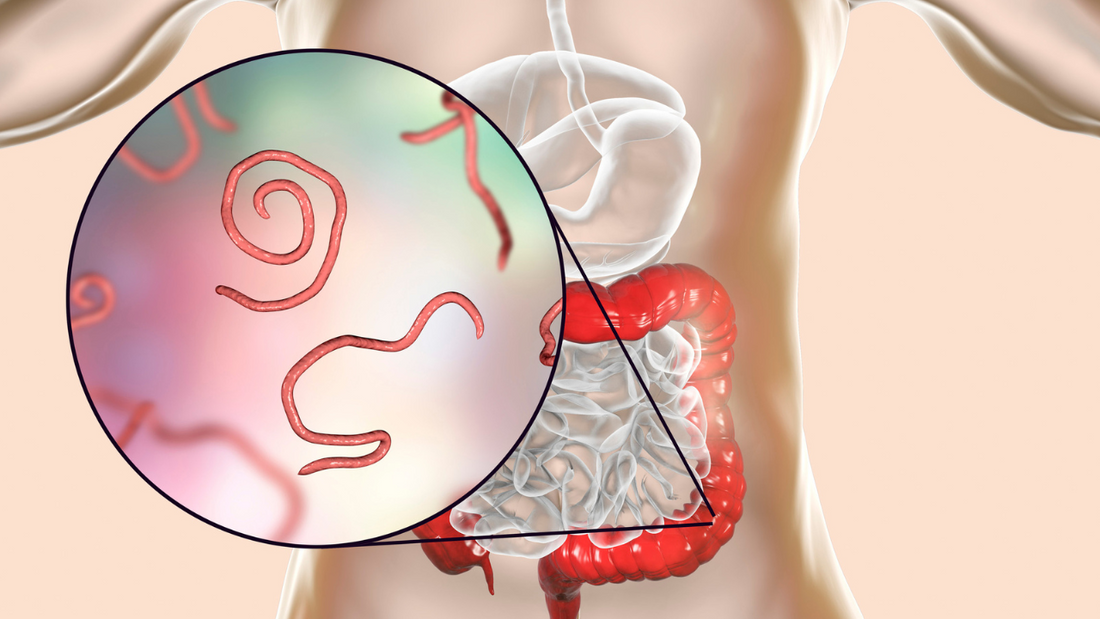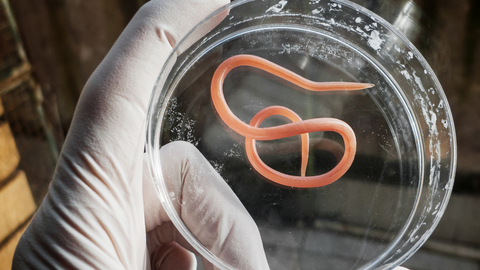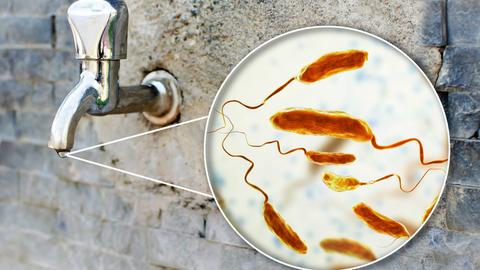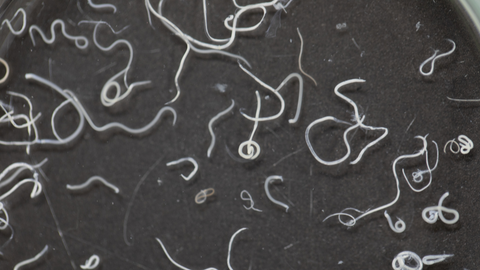What Are Parasitic Worms? Exploring Their Types, Transmission, Symptoms, Prevention and Treatment

Share
A parasite is any kind of organism that feeds on a host organism, usually at the host's expense. There are countless parasitic organisms in nature. However, of the many different species of parasites, there are three main categories that they full under – protozoa (microscopic, single-celled parasites), ectoparasites (parasites that live external to the body, such as lice, fleas, and ticks), and parasitic worms.
Parasitic worms are incredibly common in nature, affecting many different kinds of species – including humans. In fact, one study estimates that one in three people worldwide suffer from at least one kind of gastrointestinal parasite. (1)
Yet, even though parasites are incredibly common, they are largely unacknowledged by the general public and even by modern healthcare. While some parasitic worms can cause little to no symptoms in the body, some can be detrimental to our health. This article aims to shed light on these parasitic organisms, their different types, health effects, symptoms, modes of transmission, treatment methods, and prevention strategies.
Understanding Parasites and Parasitic Worms

Parasites are organisms that live on or inside a host organism and benefit by deriving nutrients at the host's expense. Among these, parasitic worms, also known as helminths, are a large and varied group of parasites that can infest humans, dogs, and other animals. (2)
Unlike other parasites that might be microscopic, many parasitic worms can be seen with the naked eye when mature. These organisms range from being microscopic during their larval stages to several meters long as adults, and they can live in a host for years. (2)
Helminths are typically classified into three main groups: flatworms (including tapeworms and flukes), roundworms (nematodes), and thorny-headed worms (acanthocephalans). Each group harbors species that have adapted to live in specific organs or tissues, from the intestines to the bloodstream and tissues.
Flatworms (Platyhelminthes)

Flatworms are characterized by their flat, ribbon-like bodies and include two main parasitic classes: Cestodes (tapeworms) and Trematodes (flukes). (3) Cestodes are segmented parasites that attach to the host's intestinal wall using hook-like structures on their head segment, known as the scolex. They absorb nutrients directly through their skin-like outer layer, bypassing the need for a digestive system. (4) Trematodes, on the other hand, often have complex lifecycles involving multiple hosts, with humans typically being the definitive hosts where they mature and reproduce. (5)
Roundworms (Nematodes)
Nematodes, or roundworms, have a cylindrical body shape that contrasts with the flat bodies of flukes and tapeworms. They can live as free-living organisms in various environments, but as parasites, they often inhabit the intestines, although some species can travel through the bloodstream and lodge in different tissues. Diseases caused by nematodes range from mild or relatively benign to severe conditions, depending on the species and the severity of infestation. (6)
Thorny-headed Worms (Acanthocephalans)

Less commonly known are the thorny-headed worms, so-called because of their spiny proboscis, which they use to latch onto the host's intestinal wall. (7) They are unique because they do not have a digestive tract; instead, they absorb nutrients directly through their body surface. While they are more common in animals, certain species can also infect humans.
The Lifecycles and Adaptations of Parasitic Worms
Parasitic worms have evolved complex lifecycles that often include intermediate hosts, which can be invertebrates like snails or insects or vertebrates such as fish or pigs. The intricate nature of these lifecycles is a testament to the parasitic worms' adaptability and ensures their survival and propagation across different environments.
For example, the lifecycle of a tapeworm begins with the ingestion of its eggs or larvae by an intermediate host. The larvae develop into infective forms within this host, which is then eaten by the definitive host, where the tapeworm reaches maturity. (8) Flukes might require two or more intermediate hosts before reaching their definitive host, displaying an even more complex lifecycle. (9)
The Impact of Parasites on Host Organisms

The presence of parasitic worms in a host can lead to a range of symptoms, from asymptomatic infestations to severe disease and, in some cases, death. The damage caused by these worms can be mechanical, from the physical presence of the worms blocking passages or damaging tissues, or metabolic, from the worms sapping essential nutrients from the host.
As parasitic worms feed on host tissues, blood, or ingested food, they deprive the host of nutrients, leading to malnutrition and weakness. Some worms can cause significant blood loss, leading to anemia. The immune response triggered by the infection can further lead to inflammatory reactions and tissue damage, exacerbating the condition. (10)
Most Common Types of Parasitic Worms in Humans
While there are numerous types of parasitic worms that can infect humans, some of the most common include:
- Ascaris lumbricoides (a type of roundworm)
- Taenia solium (pork tapeworm)
- Schistosoma species (blood flukes).
- Enterobius vermicularis (pinworm)
- Necator americanus (hookworm)
- Trichuris trichiura (whipworm)
Parasitic Worms in Dogs
Dogs are also commonly affected by parasitic worms like Toxocara canis (roundworms), Dipylidium caninum (tapeworms), and Ancylostoma species (hookworms). These parasites can lead to conditions ranging from mild discomfort to severe health issues, including diarrhea, weight loss, and anemia.
Parasites are commonly spread by dogs, cats, and other pets to their human owners, highlighting the importance of good hygiene and prevention measures for both humans and their pets.
Transmission: How People Get Infected

The ways in which people become infected with parasitic worms are numerous and varied, often linked to environmental, social, and economic factors. These infections are more common in places with inadequate sanitation and hygiene practices, affecting millions globally. Some of the common modes of transmission include:
- Contaminated Food: Consuming unwashed fruits and vegetables can lead to infections like:
- Ascaris lumbricoides, which is often transmitted when foods are contaminated with fecal matter containing Ascaris eggs.
-
Fasciola hepatica, the liver fluke, can infect individuals who consume watercress or other freshwater plants harboring the larvae.
- Contaminated Water: Drinking or coming into contact with water containing infectious larvae can cause infections such as:
- Schistosoma species, where larvae released by freshwater snails penetrate the skin of people in infected water.
-
Giardia lamblia, though not a worm but a protozoan, is worth mentioning for its waterborne transmission.
- Direct Skin Contact: Some parasites can directly penetrate the skin, leading to infections, including:
-
Ancylostoma duodenale and Necator americanus, the hookworms, can directly penetrate the skin of a person walking barefoot on contaminated soil.
- Insect Bites: Certain parasitic worms are transmitted via insect vectors, such as:
-
Wuchereria bancrofti, causes lymphatic filariasis and is transmitted through the bites of infected mosquitoes.
- Undercooked Meat: Consuming meat that is not cooked properly can lead to worm infections such as:
- Taenia solium, the pork tapeworm, can be contracted by eating undercooked pork containing larval cysts.
- Trichinella spiralis, responsible for trichinosis, is contracted through undercooked meat, especially wild game or pork.
- Improper Hygiene: Poor personal hygiene practices can also lead to the transmission of parasitic worms:
- Enterobius vermicularis or pinworm, which is transmitted when eggs are ingested after coming into contact with contaminated surfaces.
Treatment: How to Get Rid of Worms

Treatment for parasitic worm infections typically involves antiparasitic medications. The specific drug and treatment duration depends on the type of worm, the severity of the infection, and the patient's overall health. For instance, albendazole and mebendazole are commonly prescribed for roundworm, whipworm, and hookworm infections. In cases of tapeworm or fluke infections, praziquantel is often the drug of choice.
If you suspect that you have a parasitic infection or are experiencing symptoms of parasites it is recommend to consult with your doctor for testing and treatment recommendations.
Additionally, there are many natural antiparasitic remedies available. For centuries, traditional medicine has utilized herbs like green black walnut hulls, sweet wormwood, and cloves to support the elimination of parasites – along with antiparasitic foods like papaya seeds, garlic cloves, and pumpkin seeds.
Our Parasite Detox Tonic is a unique blend containing therapeutic extracts of three of the most potent antiparasitic herbs, supporting the elimination of the egg, larva, and adult stages of a variety of parasites. For an even deeper cleanse, our Para-Clear & Gut Cleanse Protocol offers a complete protocol with supplement and dietary recommendations for supporting the elimination of parasites.
Again, you should consult with your doctor before using these remedies to make sure they are right for you, especially if you are currently taking any kind of prescription medication.
Prevention: Avoiding Exposure

While it is possible to get rid of parasitic infections, it is best to try to avoid getting one in the first place. Preventing parasitic worm infections involves a combination of personal hygiene, food safety, and environmental measures. Regular handwashing, especially before eating and after using the toilet, is crucial. It's also important to wash fruits and vegetables thoroughly and cook meat properly to kill any larvae or eggs.
In areas where soil-transmitted helminths are common, wearing shoes outdoors can prevent skin contact with contaminated soil. For pet owners, regular deworming of dogs and good hygiene practices can reduce the risk of transmission from pets to humans.
The Role of the Immune System in Eliminating Parasites
An interesting aspect of the body's defense against parasitic worms is the role of specific types of leukocytes. Eosinophils, a type of white blood cell, are particularly known for their ability to kill parasitic worms by bombarding them with digestive enzymes. These cells are part of the body's immune response to infections by parasites, helping to control the spread and impact of these invaders.
Treating parasitic infections often involves following a holistic protocol that encompasses antiparasitic remedies as well as dietary and lifestyle changes. Additionally, supporting the immune system by arming it with good nutrition and immune-boosting compounds can help support the optimal functioning of the immune system, encouraging its role of eliminating parasites and other harmful pathogens.
Summary
Parasitic worms are a diverse group of organisms that can have significant health impacts on humans and animals. Understanding the different types of parasitic worms, their transmission routes, symptoms, and treatment options is crucial for prevention and management. With effective measures in place, including improved sanitation, personal hygiene, and appropriate medical treatment, the burden of parasitic worm infections can be significantly reduced.
References
1 https://www.ncbi.nlm.nih.gov/pmc/articles/PMC9867574/
2 https://www.ncbi.nlm.nih.gov/books/NBK8282/
3 https://pubmed.ncbi.nlm.nih.gov/28376328/
4 https://www.ncbi.nlm.nih.gov/books/NBK8399/
5 https://www.ncbi.nlm.nih.gov/books/NBK8037/
6 https://www.ncbi.nlm.nih.gov/pmc/articles/PMC6827559/
7 https://www.ncbi.nlm.nih.gov/pmc/articles/PMC8525584/
8 https://www.ncbi.nlm.nih.gov/books/NBK537154/
